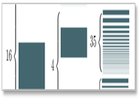Projects by Faculty Member: Jevin West

We are drowning in bullshit. Our digital environments have become less sincere and reliable. False rumors are traveling faster than true rumors. To help combat the spread of misinformation, Jevin and his colleague, Carl Bergstrom,developed a class titled, Calling Bullshit: Data Reasoning in a Digital World. The goal of the class is to teach students and the public, at large, how to spot and refute BS wrapped in numbers, statistics, and algorithms.

VizioMetrics is an image search engine and classifier. In order to improve it, we would like to automatically identify a “central figure” in a scientific article in cases when multiple figures are present. We defined “central figure” as a single visualization that encapsulates key aspects of a paper, a graphical summary that captures the content of the article for readers at a single glance. We surveyed 488,590 researchers in the biomedical field and found out that for an overwhelming majority of papers their authors were able to identify a single “central figure.”

Researchers and consumers are inundated with papers to read and products to buy. Using network algorithms, we are developing recommendation engines that help people navigate large knowledge networks.

For hundreds of years, scientists have been laying down trails of citations. These trails form a vast network, where papers are nodes and citations are links. This network can tell us a lot about the formation of new ideas, fields, and technology. We can identify salient papers and authors. We can construct maps that help us navigate this ever growing network. And we can better understand how information flows in social systems. These are some of the goals of the Eigenfactor Project (http://www.eigenfactor.org).

Gender disparities are decreasing overall in academia. However, we find in this data driven study that the story is a bit more complicated. Examining more than 8 million academic papers, we find that, in certain fields, women are underrepresented as signle authored papers and that men are over represented in the first and last author positions. You can explore the data for hundreds of fields of science using the following interactive visualization (http://www.eigenfactor.org/gender/).
